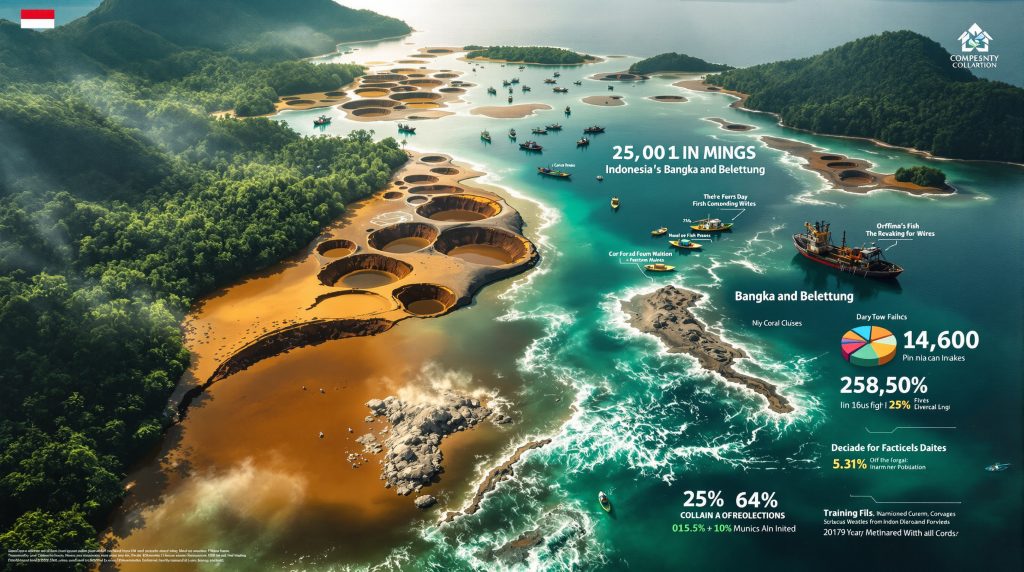The Environmental and Social Impact of Illegal Mining in Bangka and Belitung
How did illegal mining become so widespread in Indonesia's tin islands?
Illegal tin mining has proliferated across Indonesia's Bangka and Belitung islands due to several interconnected factors. The region's rich tin deposits, which account for approximately 90% of Indonesia's tin resources, have attracted both legal and unauthorized operations. Economic pressures, including limited alternative employment opportunities and the potential for quick profits, have driven many local residents to engage in unauthorized mining activities.
The regulatory landscape has been characterized by enforcement challenges, with local authorities struggling to monitor vast mining areas effectively. This situation has been complicated by reported instances of corruption within monitoring systems, allowing illegal operations to continue despite formal prohibitions. Additionally, the decentralization of governance in Indonesia has sometimes led to conflicting policies between national and local authorities, creating regulatory gaps that illegal miners exploit.
Historical context also plays a role—informal mining has been practiced in these islands for generations, making it culturally embedded in some communities. As global demand for tin has increased, particularly for use in electronics manufacturing, the economic incentives for illegal mining have grown substantially. Indonesia's position as the world's second-largest tin producer after China has made these islands strategically important in the global tin market.
What environmental damage has illegal tin mining caused in Bangka-Belitung?
Terrestrial Ecosystem Destruction
The environmental impact of illegal mining in Bangka and Belitung has been severe and multifaceted. On land, unauthorized mining operations have transformed once-forested landscapes into barren moonscapes characterized by large excavation pits. These operations have cleared substantial areas of native vegetation, including protected forest zones, disrupting natural habitats and fragmenting ecosystems.
Soil erosion has accelerated dramatically in mining areas, with topsoil being stripped away and rendering land infertile for agriculture. The creation of mining pits without proper rehabilitation has led to standing water accumulation, creating breeding grounds for disease vectors like mosquitoes. During heavy rainfall, these disturbed landscapes experience increased flooding, with documented cases of mining-related floods damaging infrastructure including roads and bridges.
Wildlife populations have declined significantly, with endemic species like tarsiers facing habitat loss. Human-wildlife conflicts have increased as animals are forced into closer proximity with human settlements, with some incidents involving estuarine crocodiles resulting in human casualties.
Marine and Coastal Devastation
Offshore illegal mining has caused even more dramatic environmental degradation. Powerful suction vessels dredge the seabed, destroying marine habitats including coral reefs that support rich biodiversity. Studies have documented up to 70% reduction in coral cover in heavily mined areas, with recovery times estimated at decades to centuries.
Coastal erosion has accelerated where mining occurs near shorelines, with some beaches disappearing entirely. Sedimentation from mining activities has reduced water clarity, inhibiting photosynthesis in marine plants and damaging seagrass meadows that serve as crucial fish nurseries.
The environmental cost has been quantified at approximately US$16.8 billion between 2015 and 2022, representing one of Indonesia's most significant environmental disasters. These estimates account for ecosystem service losses, biodiversity impacts, and future rehabilitation costs.
How has illegal mining affected local communities and livelihoods?
Disruption of Traditional Fishing Communities
Fishing communities have been particularly hard-hit by illegal mining activities. Offshore mining operations have devastated fish habitats, leading to documented declines in fish populations of up to 60% in some areas. This environmental degradation has directly translated to economic hardship for fishing families, with reports indicating income reductions of 40-50% for fishers in affected regions.
The turbidity caused by mining sediment has forced fishers to travel farther from shore to find viable fishing grounds, increasing both their fuel costs and safety risks. Some fishing communities report abandoning their traditional livelihood entirely due to the collapse of local fish stocks. This shift has disrupted generations of cultural practices and traditional knowledge systems tied to fishing.
Social Conflict and Community Division
Illegal mining has created significant social tensions within communities. Conflicts have erupted between miners and environmental activists or fishing communities, sometimes escalating to intimidation and violence. In Kelabat Bay, where mining is officially prohibited under provincial zoning regulations, confrontations between illegal miners and protesting fishers have been documented.
Communities have also experienced internal divisions, with some residents benefiting economically from mining while others suffer from its environmental consequences. These divisions have weakened traditional community structures and social cohesion, leading to the breakdown of cultural institutions and cooperative mechanisms that previously helped communities manage shared resources.
Health and Safety Concerns
Health impacts include respiratory problems from dust exposure, increased malaria incidence due to standing water in abandoned mining pits, and potential heavy metal contamination of water sources. Safety hazards are also significant, with poorly secured mining pits causing drownings, particularly during rainy seasons when pits fill with water.
Local healthcare systems report treating numerous mining-related injuries and respiratory conditions, placing additional burdens on already limited medical infrastructure. The hidden health costs of illegal mining extend to mental health issues, with community members reporting increased stress and anxiety related to environmental degradation and economic uncertainty.
What enforcement challenges do authorities face in combating illegal mining?
Resource and Capacity Limitations
Law enforcement agencies face substantial challenges in addressing illegal mining. The geographic scope of mining activities, spanning both land and sea across two islands, makes comprehensive monitoring extremely difficult with limited personnel. Enforcement operations require specialized equipment and training, particularly for offshore operations, which many local agencies lack.
Budget constraints further limit the frequency and effectiveness of enforcement actions. When illegal operations are detected, they can quickly relocate or temporarily suspend activities, resuming once enforcement personnel have departed. This cat-and-mouse dynamic has made sustained enforcement difficult despite periodic crackdowns.
Corruption and Political Interference
Reports indicate that corruption has undermined enforcement efforts at various levels. Some illegal mining operations allegedly operate with the tacit approval of local officials in exchange for payments. Political connections have reportedly shielded larger illegal operations from serious consequences, with penalties often limited to minor fines rather than criminal prosecution.
The situation has been complicated by the involvement of the state-owned mining company in what became Indonesia's largest corruption and mining scandal before 2025. This has created a challenging environment where distinguishing between legal and illegal operations becomes blurred.
Regulatory Complexity and Jurisdictional Overlap
The regulatory framework governing mining in Indonesia involves multiple agencies with overlapping jurisdictions, including the Ministry of Energy and Mineral Resources, the Ministry of Environment and Forestry, provincial governments, and district authorities. This complexity creates coordination challenges and potential gaps in enforcement.
Maritime boundaries further complicate enforcement, with unclear delineation of authority between naval forces, maritime police, and fisheries enforcement agencies for offshore mining violations. This jurisdictional confusion sometimes allows illegal miners to operate in boundary areas where responsibility for enforcement is contested.
What solutions are being implemented to address illegal mining issues?
Strengthened Enforcement Mechanisms
Recent efforts to combat illegal mining have shown some promise. In 2025, a specialized task force was established targeting illegal mining in Bangka and Belitung, focusing not only on the miners themselves but also on the intermediaries who facilitate the trade of illegally mined ore.
Technological solutions are increasingly being deployed, including satellite monitoring and drone surveillance to detect illegal operations in remote areas. Community reporting systems have been established, allowing residents to anonymously report illegal mining activities through mobile applications. These digital tools have improved response times and targeting of enforcement operations.
Regulatory and Market-Based Approaches
Indonesia has implemented mandatory trading of refined tin through authorized exchanges to improve traceability throughout the supply chain. This system aims to prevent illegally mined tin from entering legitimate markets by requiring documentation of origin for all tin products.
International certification schemes have been adopted by some companies, with pressure from electronics manufacturers concerned about sourcing minerals from environmentally damaging operations. These market-based approaches create economic incentives for legal compliance and sustainable mining innovations.
Community Engagement and Alternative Livelihoods
Sustainable development initiatives are focusing on creating alternative economic opportunities for communities currently dependent on illegal mining. These include ecotourism development, sustainable agriculture programs, and vocational training in sectors such as manufacturing and services.
Community-based environmental monitoring programs have empowered local residents to participate in protection efforts, creating a sense of ownership over natural resources. Some communities have established local conservation areas where mining is prohibited by community consensus, with enforcement supported by traditional leadership structures.
How is rehabilitation of damaged ecosystems progressing?
Land Reclamation Efforts
Rehabilitation of terrestrial mining sites has begun in some areas, though progress remains limited relative to the scale of damage. Land reclamation techniques include recontouring mining pits, replacing topsoil, and replanting native vegetation. However, full ecosystem recovery faces significant challenges, including soil compaction, altered hydrology, and the loss of seed banks.
Pilot projects have demonstrated that rehabilitated areas can recover partial ecological functionality within 5-10 years with intensive management, though full restoration to pre-mining conditions may take decades or may be impossible in severely degraded areas. The cost of comprehensive land rehabilitation has been estimated at $8,000-15,000 per hectare, creating financial barriers to widespread implementation.
Marine Habitat Restoration
Marine restoration efforts have focused on artificial reef creation in areas where natural reefs were destroyed by mining. These structures provide habitat for marine organisms and can accelerate natural recovery processes. Early results show colonization by coral species and increased fish populations around artificial reef structures, though at lower diversity than natural reefs.
Mangrove replanting along coastlines aims to reduce erosion and provide habitat for juvenile fish species. These efforts have shown moderate success, with survival rates of planted mangroves reaching 60-70% in suitable areas. However, the scale of marine rehabilitation remains small compared to the extent of damage.
What is the future outlook for Bangka and Belitung's environment and communities?
Transition Toward Sustainable Development
The future of Bangka and Belitung depends significantly on the success of current initiatives to combat illegal mining and transition toward sustainable development models. Economic diversification efforts, including tourism development and sustainable agriculture, show promise for reducing dependence on mining.
The islands' natural beauty, with white sand beaches and unique granite formations, provides potential for ecotourism development that could generate alternative income while incentivizing environmental protection. Several pilot projects have demonstrated viable models for community-based tourism that distribute economic benefits more equitably than mining.
Challenges and Opportunities
Significant challenges remain, including the rehabilitation of already damaged ecosystems and addressing the socioeconomic needs of communities currently dependent on illegal mining. The transition period may involve economic hardship for some segments of the population as mining activities are curtailed before alternative livelihoods are fully established.
However, opportunities exist for Bangka and Belitung to become a model for sustainable development in post-mining landscapes. International interest in supporting environmental restoration and mine reclamation efforts provides potential funding sources for ambitious rehabilitation projects.
How does illegal mining in Bangka-Belitung affect the global tin market?
Supply Chain Implications
Illegal mining in Bangka and Belitung has significant implications for the global tin market. Indonesia ranks as the world's second-largest tin producer after China, with Bangka-Belitung providing the majority of this production. Illegal mining contributes substantially to market supply, though exact quantities remain difficult to determine due to the unregulated nature of these operations.
This unregulated production creates market distortions, including price volatility and uncertainty about actual supply levels. When enforcement actions temporarily reduce illegal mining, market prices may spike in response to perceived supply constraints. In the first half of 2025, for instance, a major Indonesian tin producer reported a 32% decrease in tin ore output and a 29% decline in refined tin production, partially attributed to efforts to curb illegal mining.
International Response and Ethical Sourcing
Global electronics manufacturers, who use tin in circuit boards and soldering, have faced increasing pressure to ensure ethical sourcing of minerals. Industry initiatives like the Responsible Minerals Initiative have developed standards for tin sourcing that exclude illegally mined materials.
These market pressures create economic incentives for formalization of mining operations and improved environmental practices. However, challenges remain in tracing tin through complex international supply chains, particularly when illegally mined material is mixed with legitimate production.
FAQ: Common Questions About Illegal Mining in Bangka and Belitung
What percentage of Indonesia's tin comes from illegal mining operations?
While precise figures are difficult to determine due to the clandestine nature of illegal operations, experts estimate that between 30-40% of Indonesia's tin production may originate from unauthorized mining activities. This represents a significant portion of global supply, as Indonesia produces approximately 25% of the world's tin.
How does tin mining contribute to Indonesia's economy?
Tin mining contributes approximately US$1.7 billion annually to Indonesia's economy through formal channels, representing about 0.15% of GDP. However, this figure does not account for illegal production, which generates additional economic activity but bypasses formal taxation and regulatory systems.
What technologies are used in illegal tin mining operations?
Illegal mining operations employ various technologies depending on their scale and location. On land, operators use excavators, water pumps, and sluice boxes for extraction and primary processing. Offshore, suction vessels pump sediment from the seabed through pipes to extract tin-bearing material. Smaller operations may use more rudimentary equipment, including manual tools and small motorized pumps.
How long will it take for ecosystems to recover from mining damage?
Recovery timeframes vary significantly based on the type and extent of damage. Terrestrial ecosystems may require 20-30 years to regain basic ecological functionality, though full restoration to pre-mining conditions may take centuries or be permanently impaired. Marine ecosystems, particularly coral reefs, have even longer recovery periods, with estimates ranging from 50-100 years for severely damaged reef systems to regain comparable biodiversity.
What happens to illegal miners when enforcement actions occur?
Enforcement responses vary widely. Small-scale miners typically face equipment confiscation and potential fines, though criminal prosecution remains rare. Larger operations with political connections often receive warnings before enforcement actions, allowing them to temporarily suspend activities. The focus of recent enforcement has shifted toward intermediaries who facilitate the trade of illegal ore, as these represent critical nodes in the supply chain.
Further Exploration:
Readers interested in learning more about environmental challenges in Indonesia's mining regions can also explore related educational content, such as illegal tin mining coverage and mining industry trends that highlight the growing importance of waste management solutions and government intervention in the sector.
Want to Identify the Next Major Mineral Discovery Before the Market Does?
Discovery Alert's proprietary Discovery IQ model provides real-time notifications of significant ASX mineral discoveries, turning complex data into actionable investment insights. Explore our dedicated discoveries page to see how historic mineral discoveries have generated exceptional returns for early investors.




